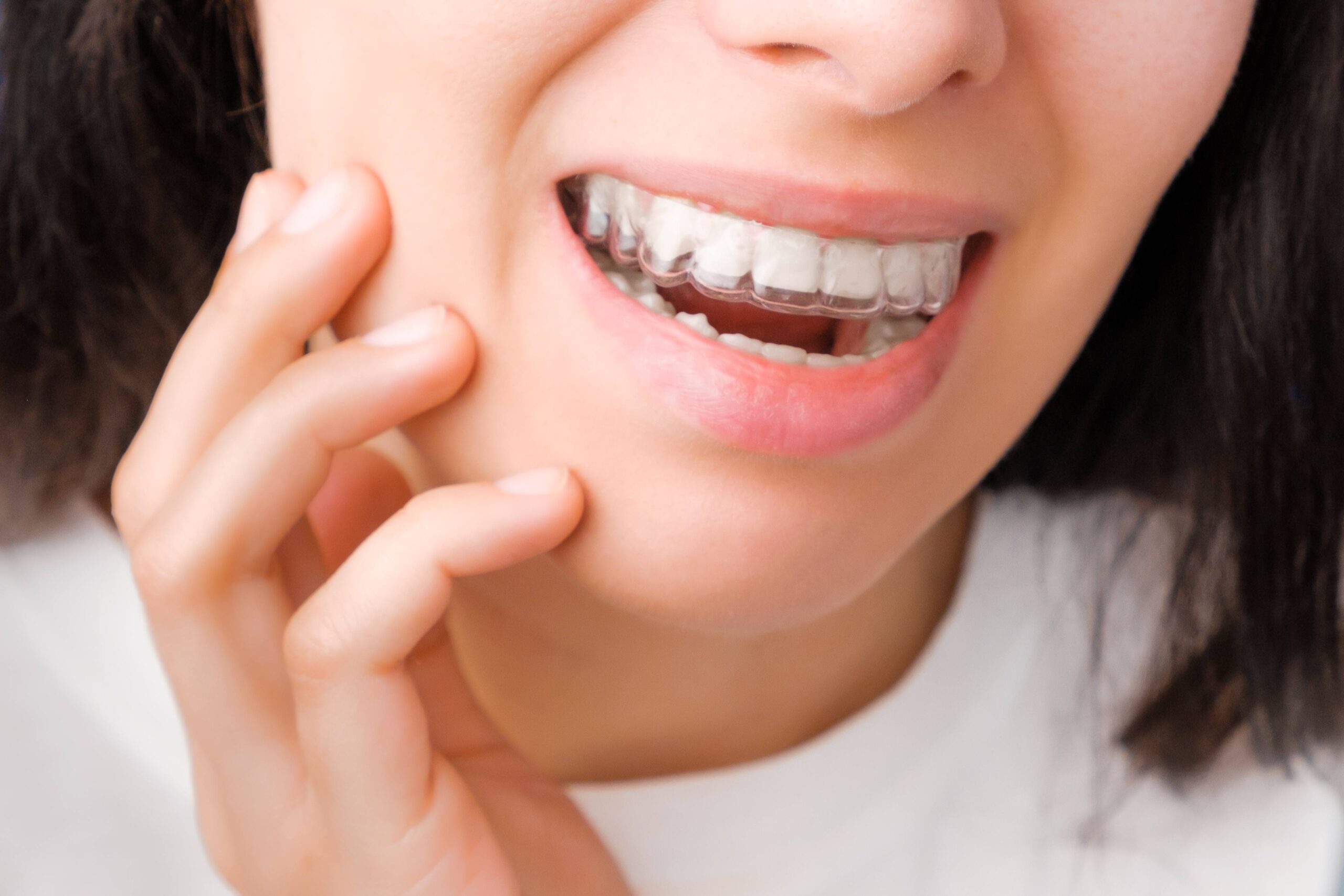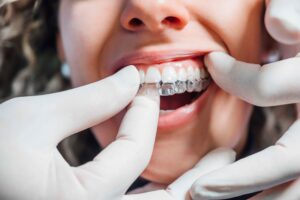Types of Braces
When it comes to improving dental alignment and achieving a beautiful smile, there are several options available. The two most common types of orthodontic treatments are traditional braces and clear aligners, also known as invisible braces. Each of these options has its own set of advantages, and the choice often depends on the individual’s specific dental needs and lifestyle preferences.
Traditional Braces
Traditional braces have been used for many years to correct a wide range of orthodontic issues. These braces consist of metallic brackets that are attached to the front surface of the teeth. A wire, known as an archwire, is threaded through these brackets and periodically adjusted by an orthodontist to gradually move the teeth into the desired position.
Despite their noticeable appearance, traditional braces are highly effective in treating complex dental issues, including severe misalignment, large gaps, and bite irregularities. They provide orthodontists with a high level of control over the movement of the teeth, allowing for precise and predictable results.
However, traditional braces do come with certain drawbacks. They can be uncomfortable, especially when the archwire is adjusted. They also require careful maintenance, as food can easily get trapped in the brackets and wires, increasing the risk of cavities and gum disease.
Clear Aligners
Clear aligners, also known as invisible braces, are a more recent addition to the world of orthodontics. They consist of a series of custom-made, transparent plastic trays that fit snugly over the teeth. Each set of trays is designed to make slight adjustments to the position of the teeth, gradually moving them towards the desired alignment.
The main advantage of clear aligners is their almost invisible appearance. They are a popular choice among adults and teenagers who want to improve their smile without the noticeable look of traditional braces. Clear aligners are also removable, allowing for easier eating, brushing, and flossing.
Moreover, clear aligners are typically more comfortable than traditional braces, as there are no brackets or wires to cause irritation. However, they may not be suitable for correcting severe orthodontic issues and require a high level of patient compliance, as they need to be worn for at least 22 hours a day to be effective.
In conclusion, both traditional braces and clear aligners can help individuals achieve a beautiful smile. The choice between the two often depends on the complexity of the dental issue, the patient’s aesthetic preferences, and their lifestyle needs. It’s important to discuss these factors with an orthodontist to determine the most suitable option.
Benefits of Clear Aligners
In the quest for a beautiful smile, clear aligners or ‘invisible braces’ have grown in popularity. They offer several advantages over traditional braces, making them an attractive choice for many. Let’s explore some of these key benefits.
Invisible Appearance
A major advantage of clear aligners is their near-invisible appearance. Unlike traditional braces, which use metal brackets and wires that are visible when you smile, clear aligners are made from transparent plastic. This means they are virtually invisible when worn. This discreet appearance can be particularly appealing to adults and teenagers who want to straighten their teeth without drawing attention to their orthodontic treatment.
Removability
Another significant benefit of clear aligners is their removability. Traditional braces are fixed in place and can only be removed by a dental professional. In contrast, clear aligners can be easily removed by the wearer for eating, drinking, brushing, and flossing. This flexibility not only makes maintaining oral hygiene easier but also allows you to enjoy all your favorite foods without worrying about damaging your braces.
Comfort
Lastly, clear aligners are generally more comfortable than traditional braces. The smooth plastic aligners lack the sharp brackets and wires of traditional braces, reducing the risk of mouth sores and irritation. Furthermore, clear aligners apply gradual pressure to move the teeth, which can be less painful than the sudden adjustments often experienced with traditional braces.
To summarize, clear aligners offer a combination of invisible appearance, removability, and comfort that can make the process of achieving a beautiful smile more pleasant and less disruptive to your daily life. As with any dental treatment, it’s important to discuss your options with a dental professional to determine the best solution for your specific needs.
Process of Getting Clear Aligners
The journey to a beautiful smile with invisible braces is a step-by-step process that involves consultation, customization, and careful monitoring of treatment progress.
Consultation
The first step in the process is an initial consultation with an orthodontist or dentist. This visit will involve a thorough examination of the patient’s teeth and oral health. The orthodontist will discuss the patient’s smile goals, explain the process of using clear aligners, and determine whether they are a good candidate for this type of treatment.
During the consultation, the orthodontist will take x-rays and photographs of the patient’s mouth. They may also take a digital scan or physical impression of the patient’s teeth. These records will be used to create a customized treatment plan for the patient.
Customization
Once the patient’s dental records have been analyzed, the orthodontist will map out a precise treatment plan. Using 3D imaging technology, they will create a digital representation of how the patient’s teeth will shift over time using clear aligners.
The customized aligners are then fabricated based on this digital plan. Each set of aligners is designed to make small adjustments to the alignment of the teeth. The aligners are made of a clear, BPA-free plastic material that is virtually invisible when worn.
The patient will typically receive several sets of custom aligners at each visit. Each set will be worn for about one to two weeks before moving on to the next set in the series. The number of aligners and the length of treatment will depend on the complexity of the patient’s case.
Treatment Progress
The patient will visit their orthodontist every six to eight weeks to monitor their progress and receive the next series of aligners. During these visits, the orthodontist will ensure that the treatment is progressing as planned and make any necessary adjustments.
Unlike traditional braces, clear aligners can be removed for eating, brushing, and flossing. However, for the treatment to be effective, the aligners should be worn for 20 to 22 hours per day.
Throughout the treatment, patients will be able to see a gradual shift as their teeth move into their ideal positions. Once the treatment is complete, they will need to wear a retainer to maintain their new smile.
The process of getting clear aligners involves a combination of advanced technology and customized care. By following their orthodontist’s instructions, patients can achieve a beautiful, straight smile with invisible braces.
Comparison with Traditional Braces
When it comes to achieving a beautiful smile, both traditional braces and invisible braces play a significant role. However, differences in effectiveness, maintenance, and cost can be a deciding factor for many.
Effectiveness
The effectiveness of traditional braces and clear aligners often depends on the complexity of the case. Traditional braces are generally more effective for severe misalignments and overcrowding, while invisible braces work best for mild to moderate cases.
| Type | Effectiveness |
|---|---|
| Traditional Braces | Excellent for severe cases |
| Invisible Braces | Excellent for mild to moderate cases |
Maintenance
Maintenance of clear aligners is generally easier than traditional braces. Clear aligners can be removed for eating and oral hygiene, making it easier to brush and floss effectively. On the other hand, traditional braces require more effort in cleaning due to the wires and brackets.
| Type | Maintenance |
|---|---|
| Traditional Braces | Requires more effort |
| Invisible Braces | Easier to maintain |
Cost
Cost can be a major factor when choosing between traditional braces and clear aligners. Generally, the cost of clear aligners is higher due to the customization and technology involved. However, the total cost can vary depending on the individual’s dental situation and the length of treatment required.
| Type | Cost |
|---|---|
| Traditional Braces | Generally lower |
| Invisible Braces | Generally higher |
In conclusion, while traditional braces and clear aligners both serve the same purpose of aligning teeth for a beautiful smile, they differ in their effectiveness, maintenance, and cost. It’s essential for individuals to consider these aspects and consult with their orthodontist to determine the best solution for their unique dental needs.
Maintenance Tips for Clear Aligners
Maintaining invisible braces is crucial for ensuring their effectiveness and preserving oral health. There are two main aspects to this: the cleaning routine and proper wear instructions.
Cleaning Routine
Invisible braces need to be cleaned regularly to prevent the build-up of bacteria and plaque. Unlike traditional braces, which are fixed to the teeth and cleaned along with them, clear aligners can and should be removed and cleaned separately. Here are some steps for an effective cleaning routine:
- Remove the Aligners: Before cleaning, the aligners need to be taken out from the mouth.
- Rinse with Warm Water: Rinse the aligners thoroughly with warm water. Avoid hot water as it can warp the plastic.
- Use a Soft Brush: Gently brush the aligners on both sides with a soft toothbrush. Do not use toothpaste or any abrasive cleaners, which can scratch the aligners and make them less clear.
- Soak for Deep Cleaning: For a deeper clean, soak the aligners in a denture cleaner or aligner cleaning solution. Follow the instructions on the product for best results.
- Rinse Again: After brushing and soaking, give the aligners a final rinse before putting them back in your mouth.
This routine should be done at least once a day, ideally at night before bed. Regular cleaning helps keep the aligners clear and invisible, and also helps prevent bad breath and cavities.
Proper Wear Instructions
Following the right wear instructions is equally important for the effectiveness of invisible braces. Here are some key points to remember:
- Wear Time: Invisible braces should be worn for 20-22 hours a day. They should only be taken out for meals and cleaning.
- Change Schedule: The aligners need to be changed to the next set in the series every 1-2 weeks, as advised by the orthodontist.
- Eating and Drinking: Do not eat or drink anything (except water) while wearing the aligners. Foods and drinks can stain or warp the aligners.
- Protecting the Aligners: When the aligners are not in the mouth, they should be kept in a protective case to avoid damage or loss.
By following these cleaning and wear instructions, users can get the best results from their invisible braces and move towards a beautiful smile with minimal discomfort or hassle.
Achieving a Beautiful Smile
Achieving a beautiful smile is a transformative journey, especially when using invisible braces. It’s not only about aesthetics but also about maintaining good oral health.
After Clear Aligner Treatment
Once the treatment with clear aligners is completed, most people notice a significant improvement in their smile. The teeth generally appear straighter and more aligned, and any prior issues with spacing or crowding are typically resolved.
However, the journey doesn’t end with the removal of the aligners. To maintain the new alignment of your teeth, you might need to wear retainers. These are similar to clear aligners in appearance but are designed to hold your teeth in their new positions. They prevent your teeth from slowly shifting back to their original positions, a natural process known as relapse.
On average, retainers are worn full-time for a few months after the aligners are removed, then transitioned to night-time use. It’s important to follow your orthodontist’s instructions about retainer usage to ensure the longevity of your treatment results.
Keeping a regular schedule of dental check-ups is also crucial. These visits allow your dentist to monitor the health of your teeth and gums, as well as the stability of your new tooth alignment. Regular cleanings can help keep your smile looking its best and prevent potential issues from developing.
Long-Term Oral Health Benefits
Besides enhancing your smile, invisible braces offer several long-term oral health benefits. Straighter teeth are generally easier to clean, reducing the risk of plaque build-up and gum disease. They also facilitate better chewing and speech function, contributing to overall oral health.
Furthermore, correcting issues like crowding or misalignment can help prevent future dental problems. For example, crowded teeth can cause uneven wear and tear, potentially leading to tooth damage over time. By resolving these issues, clear aligners can contribute to the longevity of your oral health.
In conclusion, invisible braces don’t just offer aesthetic benefits—they also play a significant role in maintaining oral health. By following the recommended post-treatment care and maintaining regular dental check-ups, you can ensure that your beautiful smile lasts a lifetime.






